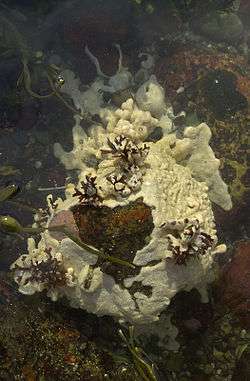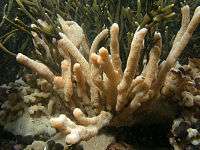Didemnum
Didemnum is a genus of colonial tunicates in the family Didemnidae. It is the most speciose genus in the didemnid family.[1][2] Species in this genus often have small calcareous spicules embedded in the tunic and form irregular or lobed colonies. Some Didemnum species, including Didemnum vexillum and Didemnum perlucidem are considered invasive species.[3] In early 2006, Didemnum vexillum was found covering a 230 km2 area of cobble habitat in Georges Bank off the coast of New England,[4] and is classified as an invasive species of greatest concern in coastal areas throughout Europe,[5] New Zealand, and North America.[3] Didemnum sp. invasions have also been recorded in Canada, the Mediterranean, and the Netherlands.[6]
| Didemnum | |
|---|---|
 | |
| Tunicate colonies of Didemnum | |
| Scientific classification | |
| Kingdom: | |
| Phylum: | |
| Subphylum: | |
| Class: | |
| Order: | |
| Family: | |
| Genus: | Didemnum Savigny, 1816 |
Species in this genus can be found in tropical or temperate regions. Some tropical species such as Didemnum molle have photosynthetic algae in their tunics.[7]
Species
- Didemnum albidum (Verrill, 1871)
- Didemnum amethysteum (Van Name, 1902)
- Didemnum asperum (Milne-Edwards, 1841)
- Didemnum biglans (Sluiter, 1906)
- Didemnum candidum (Savigny, 1816)
- Didemnum carnulentum (Ritter and Forsyth, 1917)
- Didemnum chilense (Arnbaeck, 1929)
- Didemnum coriaceum (Von Drasche, 1883)
- Didemnum fulgens (Milne-Edwards, 1841)
- Didemnum galacteum (Lotufo and Dias, 2007
- Didemnum gelatinosum
- Didemnum helgolandicum
- Didemnum lahillei (Hartmeyer, 1909)
- Didemnum maculosum (Milne-Edwards, 1841)
- Didemnum molle (Herdmann, 1886)
- Didemnum perlucidem (Monniot, 1983)
- Didemnum proliferum (Kott, 1981)
- Didemnum santaelenae (Van Name, 1945)
- Didemnum studeri (Hartmeyer, 1911)
- Didemnum tenue (Herdmann, 1886)
- Didemnum vanderhorsti (Van Name, 1924)
- Didemnum vexillum (Kott, 2002)

References
- Moreno, T.; Rocha, R. (June 2008). "Phylogeny of the Aplousobranchia (Tunicata: Ascidiacea)". Revista Brasileira de Zoologia. 25 (2): 269–298. doi:10.1590/S0101-81752008000200016.
- Kott, Patricia (15 Aug 2001). "The AUSTRALIAN ASC1DIACEA PART 4, APLOUSOBRANCHIA (3), DIDEMNIDAE". Memoirs of the Queensland Museum. 47.
- "Marine Nuisance Species". Woods Hole Coastal and Marine Center. 17 February 2016.
- Valentine, Page C.; Carman, Mary R.; Blackwood, Dann S.; Heffron, Erin J. (2007). "Ecological observations on the colonial ascidian Didemnum sp. in a New England tide pool habitat". Journal of Experimental Marine Biology and Ecology. 342 (1): 109–121. doi:10.1016/j.jembe.2006.10.021.
- Ian Laing; James Bussell; Kate Somerwill. "Project report: Assessment of the impacts of Didemnum vexillum and options for the management of the species in England".
- "Invasion der Pfankuchen" Der Spiegel, 1/2006, p. 102
- Ruppert, Edward E.; Richard S. Fox; Robert D. Barnes (2004). Invertebrate Zoology: A Functional Evolutionary Approach (7th ed.). Delhi, India. ISBN 8131501043. OCLC 970002268.
- (USGS) National Geologic Studies of Benthic Habitats, Northeastern United States has a Marine Nuisance Species page dedicated to this genus